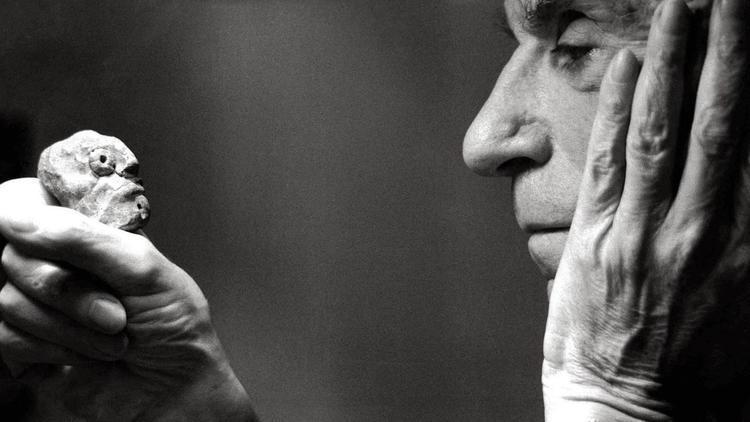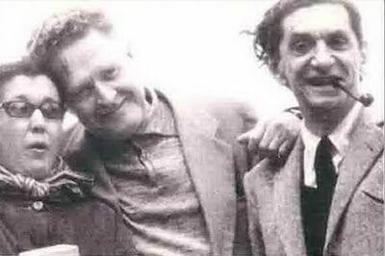'Can you paint the picture of happiness for me, Abidin?
ISTANBUL-Anadolu Agency

“Can you paint the picture of happiness for me, Abidin?” is a well-known phrase for Turks, which was addressed by the “romantic communist” of Turkish poetry Nazım Hikmet to the brilliant painter Abidin Dino. A pioneer in modern Turkish art, Dino held countless exhibitions and contributed to the promotion of Turkish art by taking his place in overseas museums. A man of many periods in history, Dino was influenced by many art movements yet he is mainly known for his abstract compositions.
Abidin Dino, one of the most prolific intellectuals of Turkish modern art, represented “diversity and versatility” in a dazzling array of creativity, say those who knew and appreciated the artist.
“Painting, drawing, original prints, sculpture, ceramics, film, theater, criticism, novels, and stories. We don’t have many artists who work in all these areas,” Turkish journalist Zeynep Avcı told Anadolu Agency.
Avcı, the author of the 2000 book Abidin Dino: From A to Z, hailed Dino as “one of the most unique figures in Turkish art history.”
Dec. 7 marks 26 years since the passing of the Turkish artist, who left the world in 1993 at age 80, claimed by cancer.
“His versatility is the leading element of his originality,” Avcı added.
Born in 1913 in Istanbul to art-loving parents, Dino spent his childhood in Geneva and Paris. He studied in French but received no formal training in the fine arts.
“He was close to socialist realism and surrealism,” said Ali Kayaalp, a research assistant on art history at Istanbul’s Mimar Sinan Fine Arts University.
“An important source of his artistic tendencies was literature rather than painting -- they were fed by literature,” Kayaalp added.
He also designed book covers for prominent Turkish writers such as Yaşar Kemal and Melih Cevdet Anday, and illustrated poems by the legendary Nazım Hikmet.

Political struggle
“He never limited his artistic production to only art, but always crowned it with a political struggle that he believed in,” said Kayaalp.
His series of paintings Patterns of Torture followed the 1951 arrests of several members of the Turkish Communist Party, an incident in which Dino was also briefly arrested and released.
“His political sentiments always pushed him to voice the values of human life and labor, and Dino was always able to take seriously the tragedies of humanity in various part of the world,” Kayaalp said.
His print series Ak La Ka Ra -- “black and white,” punning on a Turkish idiom meaning “hard put” -- visualizes the 1986 Chernobyl nuclear meltdown, a disaster which frightened many in northern Turkey, just across the Black Sea from Ukraine, where the catastrophe occurred.
“The cost of this political struggle was heavy,” Kayaalp said. “Dino lived under constant surveillance and his creations -- especially his writings -- were censored or banned.”
But his forced exile in central and southeastern Turkey also had the unintended benefit of bringing him closer to the people of Anatolia, the Turkish heartland, which resulted in the creation of his paintings Patterns of Anatolia.
In 1966, he even directed a documentary, Goal! The World Cup, now rated 7.4 out of 10 on the Internet Movie Database (IMDb) and lauded by one user as the “finest sports documentary ever made … Bury me with this film.”
“If it wasn’t for Abidin Dino, Turkish art would lack the diversity and versatility he represented,” said Kayaalp.
Paris art scene
Dino’s contributions to the recognition and visibility of Turkish contemporary art abroad are undeniable, Kayaalp added.
“Especially during his Paris years, his friendships with Parisian intellectuals made an important contribution to the recognition of Turkish art,” he added.
Dino had several stays in Paris during his life, including 1952, when he was 38, when he was forced into exile and again traveled to Europe’s cultural capital.
It was during these Paris years that Avcı met with Dino through Ara Güler, a legendary Turkish-Armenian photographer.
In the second half of the 20th century, during Dino’s years in Paris, the city was alive with active art movements.
Legendary artists of the time such as Pablo Picasso and Marc Chagall lived in the city at the same time Dino did, and in fact he ended up working with both.
In a 1979 article in Milliyet Sanat, a Turkish magazine, Dino recalled his time working with Picasso and Chagall on the French Riviera.
“I was out of money when I arrived in Paris,” wrote Dino, adding that the famed Cubist painter invited him to work at his studio in Vallauris, on the French Mediterranean, next to Cannes.
“And I went there. I was working in the ceramics studio, but I wasn’t a ceramics artist. It was a brief sojourn in my art life.
“Of course, it was an extraordinary privilege to work with Picasso every day and with Chagall, three days a week, at the same table.”
In the same article, he told of a compliment Picasso paid him. “It is only you and I who know how to draw a proper hand pattern,” Picasso told him, said Dino, adding that the Spanish artist “liked my [hand] drawings very much.”
Citizen of the world
Dino was a “citizen of the world” wherever he lived -- Paris, Rome, Leningrad -- and could get along well with people from any country or any creed, according to Avcı.
Kayaalp agreed with her, adding, “He is also everywhere, because Abidin is a citizen of the world, and at the same time the world is his homeland.”
Now, a quarter-century after his death, Dino's works are in the hands of private collectors, or are displayed in museums around the world, from Turkey to France, and from the U.S. to Algeria.
“The final stage of his artistic production took place in Paris,” said Kayaalp, referring to Dino’s passing in 1993 in Paris.
“But the origins of this production lie in Anatolia,” he explained.
















